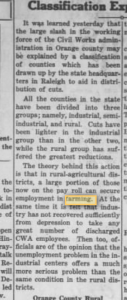Sarah Grubbs
AMST 276

An article in the Daily Tar Heel discussing the CWA cuts and farming as employment.
The years 1920-1939 were characterized by the prohibition of the production, transportation and sale of alcohol, along with a severe worldwide economic depression known as The Great Depression. The Prohibition period, from 1920-1933, blocked production and sale of alcoholic beverages which eventually led to increased illegal production of alcohol due to the difficulty federal and local governments faced attempting to enforce the blockage. Additionally, from the years of 1929-1939, the stock market crashed, consumer spending decreased, and America was left in the worst economic slump in the history of the industrialized world. During this time period, Americans struggled to protect all of their belongings and their families due to the large-scale fall of the economy. Farming proved itself to be a way for those directly affected by the Depression to begin rebuilding economically and maintain a stable income in order to protect their lives. [1]
The item I analyzed is a newspaper article from The Daily Tar Heel published in 1934. The article discusses the large cut within the workforce of the CWA in Orange County. The reason, as explained in the article, for this cut is contributed to the classifications of counties as rural, semi-industrial, and industrial. The classification of counties was believed to support the distribution of cuts. The rural group suffered the biggest cut, due to the idea that those who lived in rural areas were able to find employment in farming. However, the problem behind this is that the industry has suffered a large unemployment problem that expands much further than the rural districts. In rural areas of Chapel Hill, farming was a simple way for the unemployed to make a living for themselves, while those in the industrial areas were suffering because they weren’t able to make a living by farming as easily. [2]
Looking into the food story for Chapel Hill during Prohibition and the Great Depression, farming was one of the only simple ways to employ people. During this time period, Chapel Hill contained rural areas where the notion of farming could soar and allow those who were suffering from the fall of the economy to regain some of what they lost. However, the industrial centers in the Chapel Hill area hindered the ability of people in those areas to find employment. Overall, farming during the years of 1920-1939 was critical in aiding unemployment.
Works Cited
[1] Amadeo, Kimberly. “Great Depression Timeline:1929-1941,” The Balance. Dash, April 30, 2018, https://www.thebalance.com/great-depression-timeline-1929-1941-4048064.
[2]“Classification Explains CWA Cut.” The Daily Tar Heel, March 3, 1934. https://universityofnorthcarolinaatchapelhill-newspapers-com.libproxy.lib.unc.edu/image/67923899/?terms=farming